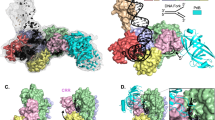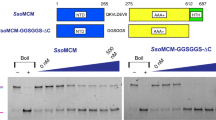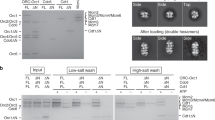Abstract
The coordinated termination of DNA replication is an important step in the life cycle of bacteria with circular chromosomes, but has only been defined at a molecular level in two systems to date. Here we report the structure of an engineered replication terminator protein (RTP) of Bacillus subtilis in complex with a 21 base pair DNA by X-ray crystallography at 2.5 Å resolution. We also use NMR spectroscopic titration techniques. This work reveals a novel DNA interaction involving a dimeric 'winged helix' domain protein that differs from predictions. While the two recognition helices of RTP are in close contact with the B-form DNA major grooves, the 'wings' and N-termini of RTP do not form intimate contacts with the DNA. This structure provides insight into the molecular basis of polar replication fork arrest based on a model of cooperative binding and differential binding affinities of RTP to the two adjacent binding sites in the complete terminator.
This is a preview of subscription content, access via your institution
Access options
Subscribe to this journal
Receive 12 print issues and online access
$189.00 per year
only $15.75 per issue
Buy this article
- Purchase on Springer Link
- Instant access to full article PDF
Prices may be subject to local taxes which are calculated during checkout




Similar content being viewed by others
Accession codes
References
Hill, T.M. In Escherichia coli and Salmonella: cellular and molecular biology. (eds Neidhardt, F.C. et al.) 1602–1614 (American Society for Microbiology, Washington DC; 1996).
Wake, R.G. FEMS Microbiol. Lett. 153, 247–254 (1997).
Wake, R.G. & King G.F. Structure 5, 1–5 (1997).
Bussiere, D.E., Bastia, D. & White, S.W. Cell 80, 651–660 (1995).
Smith, M.T., de Vries, C.J., Langley, D.B., King, G.F. & Wake, R.G. J. Mol. Biol. 260, 54–69 (1996).
Griffiths, A.A. & Wake, R.G. J. Bacteriol. 182, 1448–1451 (2000).
Kamada, K., Horiuchi, T., Ohsumi, K., Shimamoto, N. & Morikawa, K. Nature 383, 598–603 (1996).
Griffiths, A.A., Andersen, P.A. & Wake, R.G. J. Bacteriol. 180, 3360–3367 (1998).
Langley, D.B., Smith, M.T., Lewis, P.J. & Wake, R.G. Mol. Microbiol . 10, 771–779 (1993).
Manna, A.C., Pai, K.S., Bussiere, D.E., White, S.W. & Bastia, D. Proc. Natl. Acad. Sci. USA 93, 3253–3258 (1996).
Manna, A. et al. Cell 87, 881–891 (1996).
Duggin, I.G. et al. J. Mol. Biol . 286, 1325–1335 (1999).
Pai, K.S. et al. EMBO J. 15, 3164–3173 (1996).
Pai, K.S., Bussiere, D.E., Wang, F., White, S.W. & Bastia, D. Proc. Nat. Acad. Sci. USA 93, 10647–10652 (1996).
Swindells, M.B. Trends Biochem. Sci. 20, 300–302 (1995).
Kralicek, A.V., Wilson, P.K., Ralston, G.B., Wake, R.G. & King, G.F. Nucleic Acids Res. 25, 590–596 (1997).
Kralicek, A.V., Vesper, N.A., Ralston, G.B., Wake R.G. & King, G.F. Biochemistry 32, 10216–10223 (1993).
Salzmann, M., Pervushin, K., Wider, G. & Senn, H, Wüthrich, K. Proc. Natl. Acad. Sci. USA 95, 13585–13590 (1998).
Salzmann, M., Wider, G., Pervushin, K., Senn, H. & Wüthrich, K. J. Am. Chem. Soc. 121, 844–848 (1999).
Talluri, S. & Wagner, G. J. Magn. Reson. B 112, 200–205 (1996).
Otwinowski, Z. & Minor, W. Methods Enzymol . 276, 307–326 (1997).
Collaborative Computing Project 4. Acta Crystallogr. D 50, 760–764 (1994).
Brünger A.T. et al. Acta Crystallogr. D 54, 905–921 (1998).
Jones, T.A., Zou, J.-Y., Cowan, S.W. & Kjeldgaard, M. Acta Crystallogr. A 47, 110–119 (1991).
Kraulis, P.J. J. Appl. Crystallogr. 24, 945–949 (1991).
Merrit, E.A. & Murphy, M.E.P. Acta Crystallogr. D 50, 869–873 (1994).
Luscombe, N.M., Laskowski, R.A. & Thornton, J.M. Nucleic Acids Res. 25, 4940–4945 (1997).
Acknowledgements
Use of the Advanced Photon Source was supported by the US Department of Energy, Basic Energy Sciences, Office of Science. Use of the BioCARS Sector 14 was supported by the National Institutes of Health, National Center for Research Resources. This research was supported by grants from the Arnold Yeldham and Mary Raine Medical Research Foundation (M.C.J.W.), the Australia Research Council Fellowship (J.A.W.) and Small Grant Schemes (M.C.J.W. and J.A.W.), and the Swedish Natural Science Research Council (G.O.). We would also like to thank G.F. King for valuable scientific discussion.
Author information
Authors and Affiliations
Corresponding author
Rights and permissions
About this article
Cite this article
Wilce, J., Vivian, J., Hastings, A. et al. Structure of the RTP–DNA complex and the mechanism of polar replication fork arrest. Nat Struct Mol Biol 8, 206–210 (2001). https://doi.org/10.1038/84934
Received:
Accepted:
Issue Date:
DOI: https://doi.org/10.1038/84934
This article is cited by
-
Host and viral transcriptional regulators in Sulfolobus: an overview
Extremophiles (2013)
-
Energetics of the protein-DNA-water interaction
BMC Structural Biology (2007)



